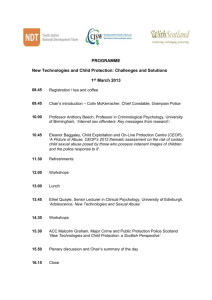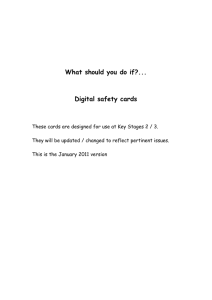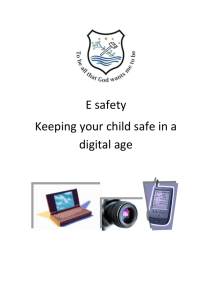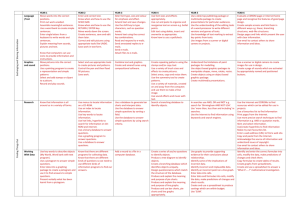NOTES FROM THE SEVENTEENTH FORMAL CEOP TELECONFERENCE ON MODEL
advertisement
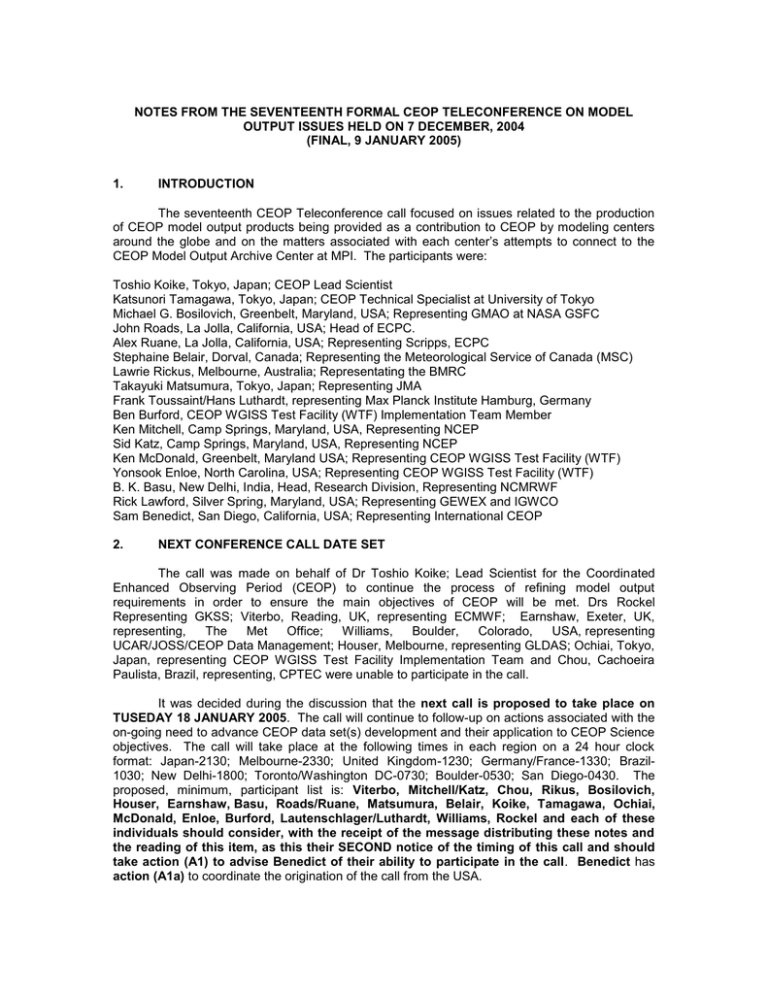
NOTES FROM THE SEVENTEENTH FORMAL CEOP TELECONFERENCE ON MODEL OUTPUT ISSUES HELD ON 7 DECEMBER, 2004 (FINAL, 9 JANUARY 2005) 1. INTRODUCTION The seventeenth CEOP Teleconference call focused on issues related to the production of CEOP model output products being provided as a contribution to CEOP by modeling centers around the globe and on the matters associated with each center’s attempts to connect to the CEOP Model Output Archive Center at MPI. The participants were: Toshio Koike, Tokyo, Japan; CEOP Lead Scientist Katsunori Tamagawa, Tokyo, Japan; CEOP Technical Specialist at University of Tokyo Michael G. Bosilovich, Greenbelt, Maryland, USA; Representing GMAO at NASA GSFC John Roads, La Jolla, California, USA; Head of ECPC. Alex Ruane, La Jolla, California, USA; Representing Scripps, ECPC Stephaine Belair, Dorval, Canada; Representing the Meteorological Service of Canada (MSC) Lawrie Rickus, Melbourne, Australia; Representating the BMRC Takayuki Matsumura, Tokyo, Japan; Representing JMA Frank Toussaint/Hans Luthardt, representing Max Planck Institute Hamburg, Germany Ben Burford, CEOP WGISS Test Facility (WTF) Implementation Team Member Ken Mitchell, Camp Springs, Maryland, USA, Representing NCEP Sid Katz, Camp Springs, Maryland, USA, Representing NCEP Ken McDonald, Greenbelt, Maryland USA; Representing CEOP WGISS Test Facility (WTF) Yonsook Enloe, North Carolina, USA; Representing CEOP WGISS Test Facility (WTF) B. K. Basu, New Delhi, India, Head, Research Division, Representing NCMRWF Rick Lawford, Silver Spring, Maryland, USA; Representing GEWEX and IGWCO Sam Benedict, San Diego, California, USA; Representing International CEOP 2. NEXT CONFERENCE CALL DATE SET The call was made on behalf of Dr Toshio Koike; Lead Scientist for the Coordinated Enhanced Observing Period (CEOP) to continue the process of refining model output requirements in order to ensure the main objectives of CEOP will be met. Drs Rockel Representing GKSS; Viterbo, Reading, UK, representing ECMWF; Earnshaw, Exeter, UK, representing, The Met Office; Williams, Boulder, Colorado, USA, representing UCAR/JOSS/CEOP Data Management; Houser, Melbourne, representing GLDAS; Ochiai, Tokyo, Japan, representing CEOP WGISS Test Facility Implementation Team and Chou, Cachoeira Paulista, Brazil, representing, CPTEC were unable to participate in the call. It was decided during the discussion that the next call is proposed to take place on TUSEDAY 18 JANUARY 2005. The call will continue to follow-up on actions associated with the on-going need to advance CEOP data set(s) development and their application to CEOP Science objectives. The call will take place at the following times in each region on a 24 hour clock format: Japan-2130; Melbourne-2330; United Kingdom-1230; Germany/France-1330; Brazil1030; New Delhi-1800; Toronto/Washington DC-0730; Boulder-0530; San Diego-0430. The proposed, minimum, participant list is: Viterbo, Mitchell/Katz, Chou, Rikus, Bosilovich, Houser, Earnshaw, Basu, Roads/Ruane, Matsumura, Belair, Koike, Tamagawa, Ochiai, McDonald, Enloe, Burford, Lautenschlager/Luthardt, Williams, Rockel and each of these individuals should consider, with the receipt of the message distributing these notes and the reading of this item, as this their SECOND notice of the timing of this call and should take action (A1) to advise Benedict of their ability to participate in the call. Benedict has action (A1a) to coordinate the origination of the call from the USA. 3. GENERAL AND ON-GOING ISSUES IN CEOP MODEL OUTPUT DEVELOPMENT 3.1 Inter-governmental ad hoc Group on Earth Observations (GEO) Koike reported that the fifth meeting of international GEO (GEO-5) was held on November 29-30, 2004 at the Château Laurier in Ottawa where approximately 275 delegates from various countries attend. GEO-5 was preceded by two days of preparatory meetings, and followed by a one day "Way Forward to Summit-III" meeting. The issues accomplished included: (a) Approval of the draft of the Ten Year Implementation Plan, (b) Agreement that the 10 year period of GEOSS implementation will begin just after accomplishment of the Earth Observation Summit III that takes place at Brussels, in Belgium on 16 February 2005. (c) Agreement that there would be a one year transistion period that would lead to the establishment of a successor mechanism to GEO, in the form of a Council and Advisory Boards and, (d) The current documents would be reviewed and refined once more at Tokyo, Japan, 11-13 January 2005 for submittal to EO-III. More information on the GEO/GEOSS process can be found at the GEO website: http://earthobservations.org. Specific documentation can be obtained through the national representatives on GEO. Koike with Lawford continue to have an action (A1b) to keep the group informed of the progress of the GEO/GEOSS processes while representing issues of importance to CEOP/GEWEX and WCRP, in general, at the appropriate meetings and in the documentation being developed for later approval by governments. 4.0 PRIORITY TOPICS IN CEOP MODEL OUTPUT DEVELOPMENT It was agreed that all contributing centers had demonstrated that they were able to accomplish the two most important activities related to development of the CEOP Model Output component. Namely the: (i) TRANSFER data (push or pull) by electronic means (FTP) to/from MPI for placement in the CEOP Database and (ii) ACCESS CEOP Model Output Database at http://www.mad.zmaw.de/CEOP. Each Center Spokesperson (Viterbo, Mitchell/Katz, Chou, Rikus, Bosilovich, Houser, Earnshaw, Basu, Roads/Ruane, Belair and Matsumura) was commended for this effort. They further agreed to continue to perform these activities on a routine basis and to report their progress in person or in writing at the time of each subsequent reporting period (aligned with the regular CEOP conference calls on this topic). 4.1 Priority Actions/Recommendations for a CEOP Model Characteristics Table All the participants were commended for their efforts to fill in the CEOP that the Model Characteristics Table at: http://www.joss.ucar.edu/ghp/ceopdm/model/model.html (scroll down). There was agreement that this table provides a unique and valuable summary/overview for each model in a concise format, which can now be used to move forward efficiently with model intercomparisons, model improvements and model forecasts. The table is also helping CEOP establish a Meta Data standard that will make the CEOP data more accessible and valuable to the broader scientific community through the CEOP central data integration system. Because there are still a number of missing elements in the table; each Center Spokesperson (Viterbo, Mitchell/Katz, Chou, Rikus, Bosilovich, Houser, Earnshaw, Basu, Roads/Ruane, Belair and Matsumura), has the on-going, action A2, to periodically review the table and to keep the entries there current. More importantly Viterbo, may wish to take special action to fill in the blanks in the Table for ECMWF models as action (A2a) or to provide an explanation for the reason the data can not be provided or a date when the data will be available for entry into the table. 4.2 MOLTS Vertical Profile Data Format With regard to the standardization of MOLTS format, which has been an on-going topic of discussion, there are a number of actions underway in parallel that are designed to provide a tool to convert ASCII MOLTS into netcdf and to offer it for usage to the CEOP model output community. Viterbo has previously agreed to continue his efforts to provide such a tool, while at the same time Rickus has developed a tool, which is being tested by Ruane, Bosilovich and Katz. The testing is planned to continue and reports on its progress will be made during up coming calls. At the same time, Matsumura reported that JMA is working with JAXA/RESTEC to enable the JMA MOLTS to also be converted to netcdf and made compatible with the GRADSDODS server being developed in the context of the CEOP data integration funtion being undertaken by JAXA and the University of Tokyo. Burford, reported that this system is being tested with the JMA MOLTS and that good progress is being made on the conversion process. At the same time, Burford, reported that the broader system was successfully demonstrated at the the CEOS meeting in November at Bejing, China. The system is continuing to undergo development, but Burford agrees that as soon as a few recently found bugs are corrected the system can be provisionally released (action A2b) to the participants in the Model Output component of CEOP to undergo controlled beta testing prior to the time of the final demo at the CEOP 4th Implementation Planning Meeting that will take place at Tokyo, Japan from 28 February to 4 March 2005 in conjuntion with the IGOS-P, Integrated Global Water Cycle Observations (IGWCO) Theme Implementation Team. It is expected that the full system would be released to the general community following the CEOP meeting, but limited testing before that time could be of value. 4.3 Provision of Model Data on Pressure Levels Versus Model Levels This item remains in work as reported at the time of the last call and is repeated here because of its continued importance to CEOP related science goals. Rockel had agreed earlier to undertake an experimental effort (action A2c) to use the data that exists in the current CEOP Model Output Database in the form of pressure levels versus model levels and to provide the group with his evaluation of its applicability in assessing LAMs. Based on the outcome of this effort, other Centers, which may be capable of providing data at pressure levels, may be asked to up-load it to MPI for users such as Rockel. A list of the most important parameters for such analyses has already been provided to all the Center Representatives for their review and comment. It is known that ECMWF and ECPC are already feeding these data into the data archive at MPI and Bosilovich agreed to upload similar data to MPI when new data are added. 4.4 CEOP Model Evaluation Exercise at 2005 International Meeting As reported during the last call, Bosilovich with Roads and Houser has taken leadership in the development of the framework for a CEOP model evaluation exercise that would begin around the time of the 2005 CEOP Fourth International Implementation Planning Meeting (28 February to 4 March 2005, Tokyo, Japan) and evolve beyond that point as a contribution to the CEOP Phase II Implementation process. Bosilovich agreed to summarize the details of this effort in an article for the CEOP Newsletter #7, that will be published in mid-January 2005, one purpose of advising the community of this work is to encourage more international participation. 4.5 CEOP WGISS Test Facility Network Support McDonald, Enloe and Burford reported that network testing of the preliminary design of the CEOP WTF server is advancing. Viterbo, Mitchell/Katz, Chou, Rikus, Bosilovich, Houser, Earnshaw, Basu, Roads/Ruane, Belair and Matsumura were asked again to take an action (A3) to contact Burford benb@restec.or.jp, with an IP address and a point of contact that would be available to participate in the test process for this capability. Enloe specifically sited further advancement of the testing with the satellite data that has been undertaken at GMU by Dr J. Galloway. At the moment the work is being done on a small server that would not allow the necessary stability to broaden testing with several outside groups. The approach being applied to provide an OPeNDAP (DODS) environment that can work with a number of “clients” including Ferret and and others. The concept is to setup an interactive computer visualization and analysis environment designed to meet the needs of the multidisciplinary CEOP community as they attempt to analyze the large and complex gridded data sets begin currently generated and staged at various central archive and distribution facilities. The system is schedule to be ported to a larger more stable server environment in the near future and at that time broader CEOP community testing will be undertaken. McDonald and Enloe agreed to action A3a to keep the group infomed of progress on this activity. 4.6 Status of Contributions to Model Output Component of CEOP/Sample Data Transfer Reports provided during the call made it clear that the work of producing and transferring the required model output to CEOP has been progressing well and some data from every Center except CPTEC, GLDAS and Environment Canada having been received, verified and placed on the CEOP Model Output Database at the Model and Data Group facility at Hamburg, Germany. Nearly completing this action for all the participants. Additionally, ECPC reported their effort to reprocess and eventually replace the data, which had been sent to M&D earlier. It was agreed further, that it would be best to show the status of each group’s contribution to CEOP through the display of the latest update of the Table of available data at the CERA Database in Hamburg as compiled by the M&D Group as they receive the data over the Internet at the CEOP Model Output Gateway. The Table below is the latest version of the available data at the Hamburg Data Center. All the Center Spokesperson (Viterbo, Mitchell/Katz, Chou, Rikus, Bosilovich, Houser, Earnshaw, Basu, Roads/Ruane, Belair and Matsumura), have an on-going action A4, to review the table and verify the level of success of their contribution up to the current time. A link to the Table can be found http://www.mad.zmaw.de/CEOP/Data_timeline.html. at the following Internet URL: There is a tabular version of the Table as well, which can be found at the following location: http://mad-web.dkrz.de/CEOP/ceop_overview.html. From that location it is possible to follow links that will lead to the actual data. Data sets included into CERA (as of 07-JAN-2005 ) Centre MOLTS data GRID data NCEP 01-DEC-2002 – 31-DEC-2004 CDAS : 01-OCT-2002 – 31-DEC-2004 (1) CDAS: - 01-OCT-2002 – 31-DEC-2002 UKMO 01-OCT-2002 – 30-SEP-2003 01-OCT-2002 – 30-SEP-2003 NASAGMAO 01-JUL-2001 - 31-OCT-2002 01-JUL-2001 - 30-SEP-2001 NASAGLDAS - - JMA 01-OCT-2002 - 31-SEP-2004 01-OCT-2002 - 31-SEP-2004 BMRC 01-OCT-2002 - 30-SEP-2003 - ECMWF - 01-JUL-2001 - 31-AUG-2002 NCMRWF - 01-OCT_2003 - 31-JAN-2004 ECPC SFM : RII : - SFM : RII : - CPTEC/INPE - (1) Analysis data are split up into time series for individual variables and levels You may also find a timeline presentation of the available data periods. There is a Change log available now! Total amount of CEOP data within CERA: appr. : 1.261 TByte

